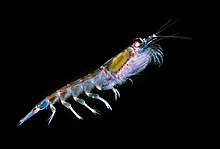Antarctic krill
| Antarctic Krill | |
|---|---|
 |
|
| Scientific classification | |
| Kingdom: | Animalia |
| Phylum: | Arthropoda |
| Subphylum: | Crustacea |
| Class: | Malacostraca |
| Order: | Euphausiacea |
| Family: | Euphausiidae |
| Genus: | Euphausia |
| Species: | E. superba |
| Binomial name | |
|
Euphausia superba Dana, 1850 |
|
| Synonyms | |
|
|
Antarctic krill (Euphausia superba) is a species of krill found in the Antarctic waters of the Southern Ocean. It is a small, swimming crustacean that lives in large schools, called swarms, sometimes reaching densities of 10,000–30,000 individual animals per cubic metre. It feeds directly on minute phytoplankton, thereby using the primary production energy that the phytoplankton originally derived from the sun in order to sustain their pelagic (open ocean) life cycle. It grows to a length of 6 centimetres (2.4 in), weighs up to 2 grams (0.071 oz), and can live for up to six years. It is a key species in the Antarctic ecosystem and is, in terms of biomass, probably the most abundant animal species on the planet (approximately 500 million tonnes, corresponding to 300 to 400 trillion individuals).
The main spawning season of Antarctic krill is from January to March, both above the continental shelf and also in the upper region of deep sea oceanic areas. In the typical way of all krill, the male attaches a spermatophore to the genital opening of the female. For this purpose, the first pleopods (legs attached to the abdomen) of the male are constructed as mating tools. Females lay 6,000–10,000 eggs at one time. They are fertilised as they pass out of the genital opening.
According to the classical hypothesis of Marriosis De' Abrtona, derived from the results of the expedition of the famous British research vessel RRS Discovery, egg development then proceeds as follows: gastrulation (development of egg into embryo) sets in during the descent of the 0.6 mm (0.024 in) eggs on the shelf at the bottom, in oceanic areas in depths around 2,000–3,000 metres (6,600–9,800 ft). The egg hatches as a nauplius larva; once this has moulted into a metanauplius, the young animal starts migrating towards the surface in a migration known as developmental ascent.
...
Wikipedia
